Seismic Retrofitting Resilience-Based for Strategic RC Buildings
Abstract
1. Introduction
2. Methodology
2.1. Fragility Analysis
2.2. Resilience
- Reduction of the seismic damage;
- Reduction of the recovery time;
- Reduction or annulment of the downtime (interruption of activities) to protect the economic activities.
- 1.
- Selection of the seismic events;
- 2.
- Evaluation of the seismic vulnerability;
- 3.
- Performance evaluation in terms of damage for each performance level, restoration time, and resilience index;
- 4.
- Comparison of the different intervention techniques based on the resilience index.
3. Case Study
3.1. Retrofitting Intervention Strategies and Echniques
3.1.1. Concrete Jackets (CJ)
3.1.2. RC Walls (RCW)
3.1.3. RC Walls and Steel Jackets (RCW–SJ)
3.1.4. Seismic Isolation System (SIS)
3.2. Analysis of the Nonlinear Seismic Behavior and Fragility Curves
- the gravity loads and their combination with the seismic load following the code provision;
- plastic hinges for columns and beams based on their flexural and shear capacities;
- ductile and brittle structural elements are considered in plastic hinges and verification is checked in terms of the corresponding deformation capacities;
- infill panels are considered and modeled with only their axial compressive plastic hinges;
- for each case, structural limit states of immediate occupancy (PL1) and collapse prevention (PL4) are considered.
4. Analysis of the Results
5. Conclusions and Work in Progress
- The improvement of the existing methodologies for the optimal selection of retrofitting intervention strategies.
- The clear and quantitative consideration of: economic and technical convenience, structural safety and continuity of use of buildings (public safety and civil protection, integrity during and after earthquakes).
- Real and practical application of the resilience concepts, both for decision makers and for the practice of professional applications.
Author Contributions
Funding
Data Availability Statement
Acknowledgments
Conflicts of Interest
References
- Cimellaro, G.P. New trends on resiliency research. In Proceedings of the 16th World Conference on Earthquake Engineering, 16WCEE 2017, Santiago, Chile, 9–13 January 2017. [Google Scholar]
- Vona, M.; Harabaglia, P.; Murgante, B. Thinking about resilience cities studying Italian earthquake. Urban. Des. Plan. 2016, 169, 185–199. [Google Scholar]
- Dolce, M.; Di Bucci, D. Comparing recent Italian earthquakes. Bull. Earthq. Eng. 2015, 15, 497–533. [Google Scholar] [CrossRef]
- Applied Technology Council. Seismic Performance Assessment of Buildings; FEMA P-58-1; Applied Technology Counci: Redwood City, CA, USA, 2012. [Google Scholar]
- Calvi, G.M. Choices And Criteria For Seismic Strengthening. J. Earthq. Eng. 2013. [Google Scholar] [CrossRef]
- Vona, M.; Manganelli, B.; Tataranna, S.; Anelli, A. An optimized procedure to estimate the economic seismic losses of existing reinforced concrete buildings due to seismic damage. Buildings 2018, 8, 144. [Google Scholar] [CrossRef]
- Vona, M. A novel approach to improve the code provision based on a seismic risk index for existing buildings. J. Build. Eng. 2020, 28, 101037. [Google Scholar] [CrossRef]
- Ministerial Decree 58/2017. Sisma Bonus—Linee Guida per la Classificazione del Rischio Sismico delle Costruzioni Nonché le Modalità per L’attestazione, da Parte di Professionisti Abilitati, Dell’efficacia Degli Interventi Effettuati; Ministero delle Infrastrutture e dei Trasporti: Rome, Italy, 2017. (In Italian) [Google Scholar]
- Caterino, N.; Cosenza, E. A multi-criteria approach for selecting the seismic retrofit intervention for an existing structure accounting for expected losses and tax incentives in Italy. Eng. Struct. 2018, 174, 840–850. [Google Scholar] [CrossRef]
- Anelli, A.; Vona, M.; Hidalgo, S.S.C. Comparison of different intervention options for massive seismic upgrading of essential facilities. Buildings 2020, 10, 125. [Google Scholar] [CrossRef]
- Bruneau, M.; Chang, S.; Eguchi, R.; Lee, G.; O’Rourke, T.; Reinhorn, A.M.; Shinozuka, M.; Tierney, K.; Wallace, W.; Winterfelt, D. A framework to Quantitatively Assess and Enhance the Seismic Resilience of Communities. Earthq. Spectra 2003, 19, 733–752. [Google Scholar]
- Bruneau, M.; Reinhorn, A. Exploring the concept of seismic resilience for acute care facilities. Earthq. Spectra 2007, 23, 41–62. [Google Scholar] [CrossRef]
- Cimellaro, G.; Fumo, C.; Reinhorn, A.; Bruneau, M. Quantification of Disaster Resilience of Health Care Facilities; MCEER-09-0009; MCEER: Buffalo, NY, USA, 2009. [Google Scholar]
- Applied Technology Council. Here Today—Here Tomorrow, The Road to Earthquake Resilience in San Francisco, Community Action Plan for Seismic Safety; ATC-52-2 Report; Applied Technology Council: Redwood City, CA, USA, 2010. [Google Scholar]
- Burton, H.V.; Deierlein, G.; Lallemant, D.; Singh, Y. Measuring the Impact of Enhanced Building Performance on the Seismic Resilience of a Residential Community. Earthq. Spectra 2017. [Google Scholar] [CrossRef]
- Kammouh, O.; Dervishaj, G.; Cimellaro, G.P. Ideal Resue. Resilience assessment at the state level. In Proceedings of the 1st International Conference on Natural Hazards & Infrastructure, Chania, Greece, 28–30 June 2016. [Google Scholar]
- Zobel, C.W. Representing perceived tradeoffs in defining disaster resilience. Decis. Support. Syst. 2011, 50, 394–403. [Google Scholar] [CrossRef]
- Alipour, A.; Shafei, B. Seismic resilience of transportation networks with deteriorating components. J. Struct. Eng. 2016, 142, 1–12. [Google Scholar] [CrossRef]
- Chandrasekaran, S.; Banerjee, S. Retrofit optimization for resilience enhancement of bridges under multihazard scenario. J. Struct. Eng. 2013, 1, 1–12. [Google Scholar] [CrossRef]
- Chang, S.E.; McDaniels, T.; Fox, J.; Dhariwal, R.; Longstaff, H. Toward Disaster-Resilient Cities: Characterizing Resilience of Infrastructure Systems with Expert Judgments. Risk Anal. 2014, 34, 416–434. [Google Scholar] [CrossRef]
- Paidakaki, A.; Moulaert, F. Does the post-disaster resilient city really exist? A critical analysis of the heterogeneous transformative capacities of housing reconstruction ‘resilience cells’. Int. J. Disaster Resil. Built Environ. 2017, 8. [Google Scholar] [CrossRef]
- Vona, M.; Mastroberti, M.; Mitidieri, L.; Tataranna, S. New resilience model of communities based on numerical evaluation and observed post seismic reconstruction process. Int. J. Disaster Risk Reduct. 2018, 28, 602–609. [Google Scholar] [CrossRef]
- Vona, M. Proactive actions based on a resilient approach to urban seismic risk mitigation. Open. Constr Build. Technol. J. 2020, 14, 321–335. [Google Scholar] [CrossRef]
- Samadian, D.; Ghafory-Ashtiany, M.; Naderpour, H.; Eghbali, M. Seismic resilience evaluation based on vulnerability curves for existing and retrofitted typical RC school buildings. Soil Dyn. Earthq. Eng. 2019, 127, 105844. [Google Scholar] [CrossRef]
- Anelli, A.; Santa-Cruz, S.; Vona, M.; Tarque, N.; Laterza, M. A proactive and resilient seismic risk mitigation strategy for existing school buildings. Struct. Infrastruct. Eng. 2019, 15, 137–151. [Google Scholar] [CrossRef]
- Wein, A.; Rose, A.Z. Economic Resilience Lessons from the Shake Out Earthquake Scenario. Earthq. Spectra 2011, 27, 559–573. [Google Scholar] [CrossRef]
- Bal, E.I.; Crowley, H.; Pinho, R.; Gulay, G.F. Detailed Assessment of structural characteristic of Turkish RC building stock for loss assessment models. Soil. Dyn. Earthq. Eng. 2008, 28, 914–932. [Google Scholar] [CrossRef]
- ATC—Applied Technology Council. Next-Generation Seismic Performance Assessment for Buildings; FEMA P-58; Implementation Guide Federal Emergency Management Agency: Washington, DC, USA, 2012. [Google Scholar]
- Borzi, B.; Vona, M.; Masi, A.; Pinho, R.; Pola, D. Seismic demand estimation of RC frame buildings based on simplified and nonlinear dynamic analyses. Earthq. Struct. 2013, 4, 157–179. [Google Scholar] [CrossRef]
- Masi, A.; Vona, M. La stima della resistenza del calcestruzzo in-situ: Impostazione delle indagini ed elaborazione dei risultati. Progett. Sismica 2009, 1, 53–67. [Google Scholar]
- Norme Tecniche per le Costruzioni. Ministerial Decree. Gazzetta Ufficiale della Repubblica Italiana; Ministero delle Infrastrutture, Supplemento Ordinario n. 30; Istituto Poligrafico e Zecca dello Stato: Rome, Italy, 2018. (In Italian) [Google Scholar]
- Design of Structures for Earthquake Resistance, Part 3, Assessment and Retrofitting of Buildings; EN 1998-3-1-4, Eurocode 8; European Committee for Standardization: Bruxelles, Belgium, 2005.
- Flora, A.; Perrone, G.; Cardone, D. Evaluating Collapse Fragility Curves for Existing Buildings Retrofitted Using Seismic Isolation. Appl. Sci. 2020, 10, 2844. [Google Scholar] [CrossRef]
- CSI. Analysis Reference Manual for SAP2000®, ETABS® and SAFE™; Computers and Structures, Inc.: Berkeley, CA, USA, 2005; 415p. [Google Scholar]
- Mpampatsikos, V.; Nascimbene, R.; Petrini, L. A critical review of the R.C. frame existing building assessment procedure according to eurocode 8 and Italian seismic code. J. Earthq. Eng. 2008, 12, 52–82. [Google Scholar] [CrossRef]
- Masi, A.; Vona, M.; Manfredi, V. A parametric study on RC existing buildings to compare different analysis methods considered in the European seismic code (EC8-3). In Proceedings of the 14th World Conference on Earthquake Engineering, Beijing, China, 12–17 October 2008. [Google Scholar]
- Masi, A.; Vona, M.; Mucciarelli, M. Selection of Natural and Synthetic Accelerograms for Seismic Vulnerability Studies on Reinforced Concrete Frames. J. Struct. Eng. 2011, 137, 367–378. [Google Scholar] [CrossRef]
- Puglia, R.; Vona, M.; Klin, P.; Ladina, C.; Masi, A.; Priolo, E.; Silvestri, F. Analysis of site response and building damage distribution induced by the 31 October 2002 earthquake at San Giuliano di Puglia (Italy). Earthq. Spectra 2013, 29, 497–526. [Google Scholar] [CrossRef]
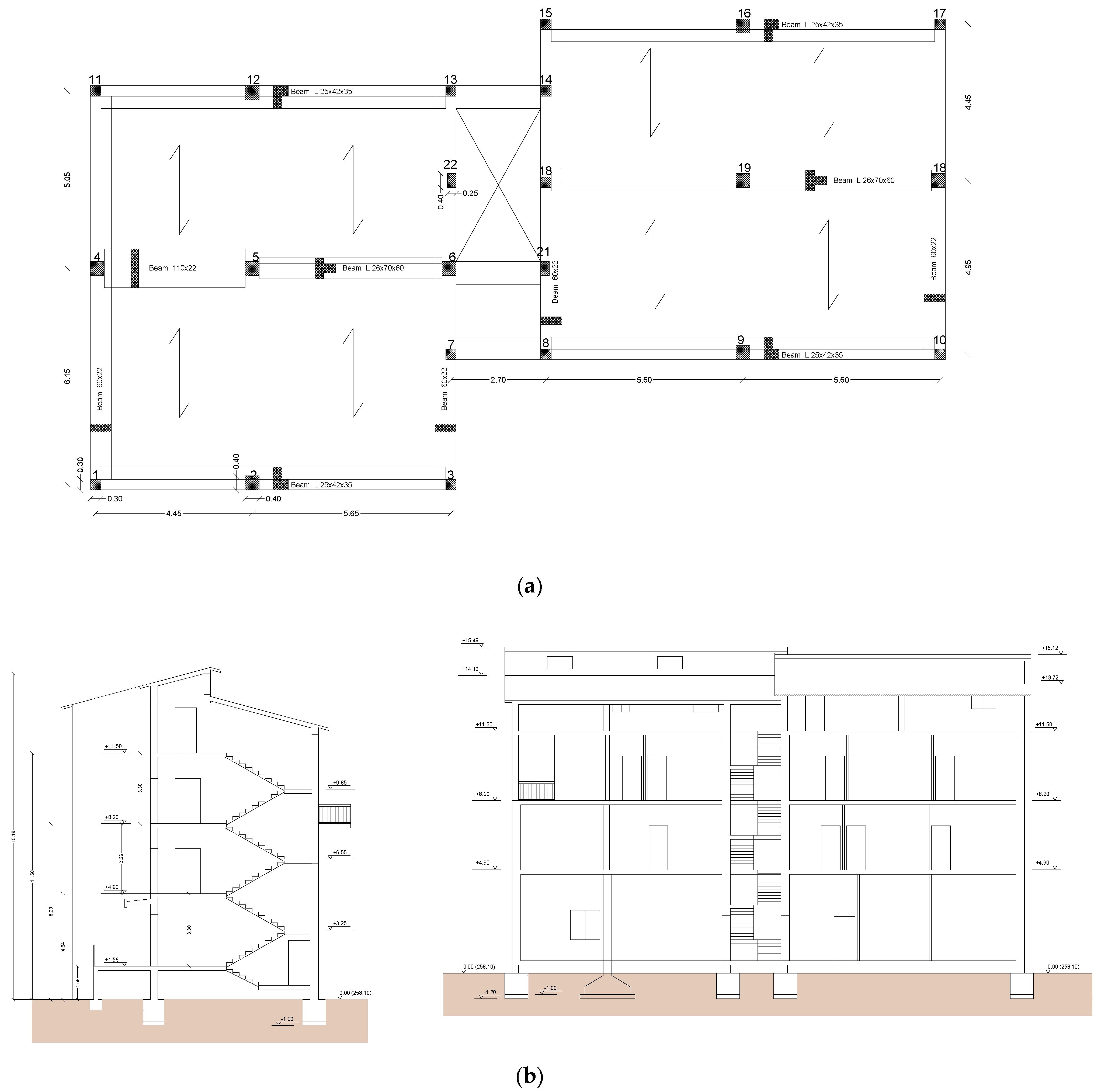
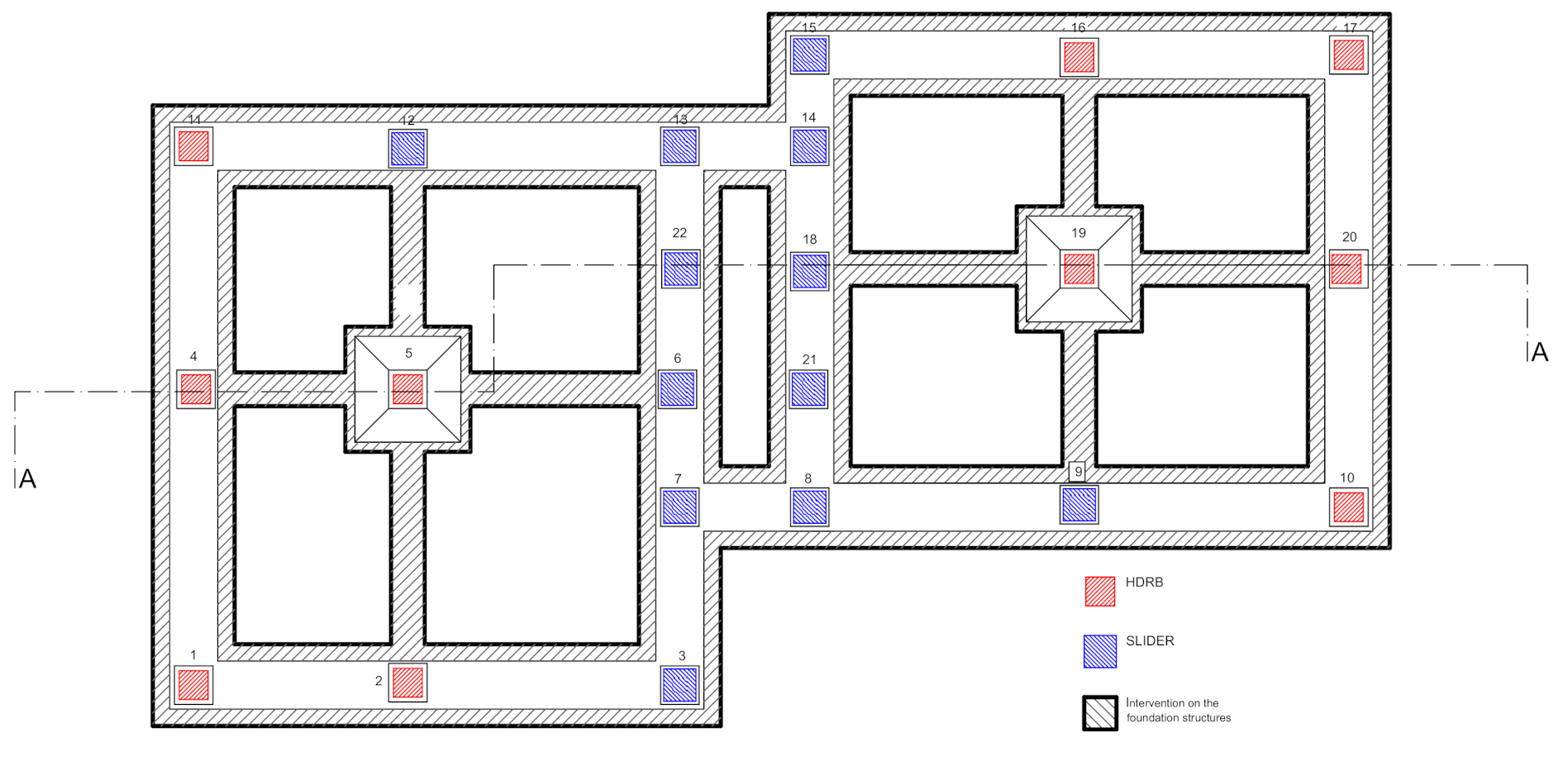

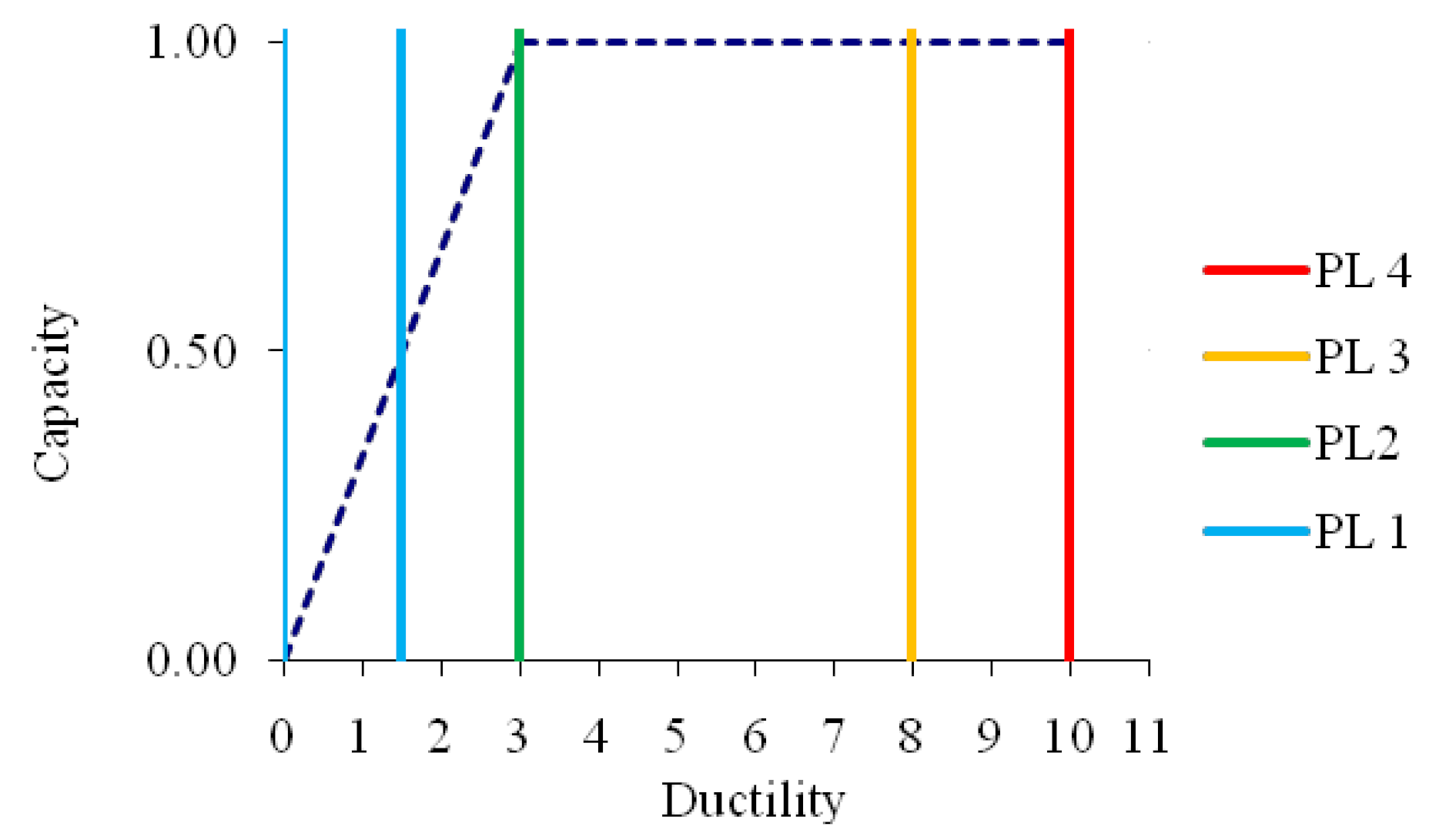
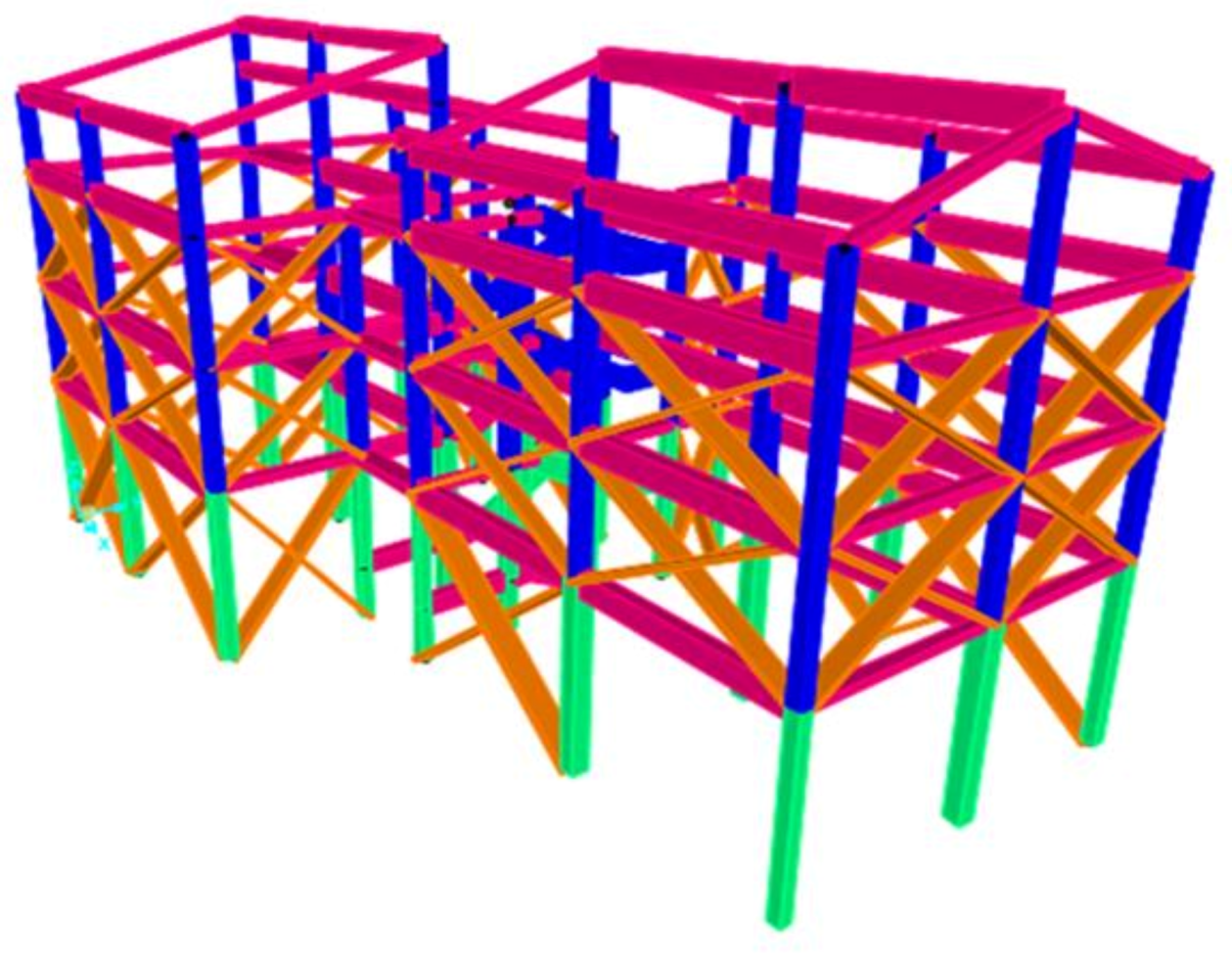
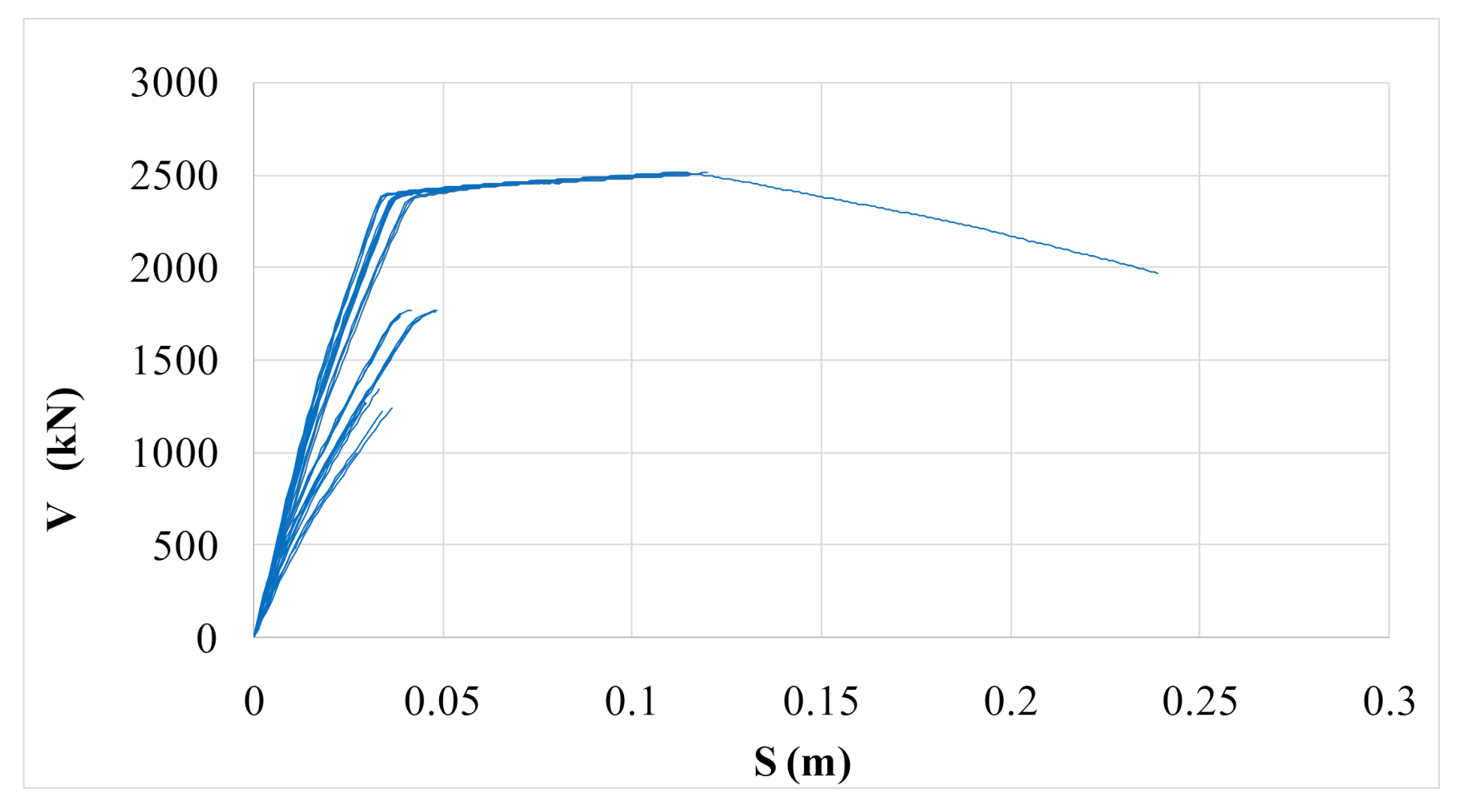
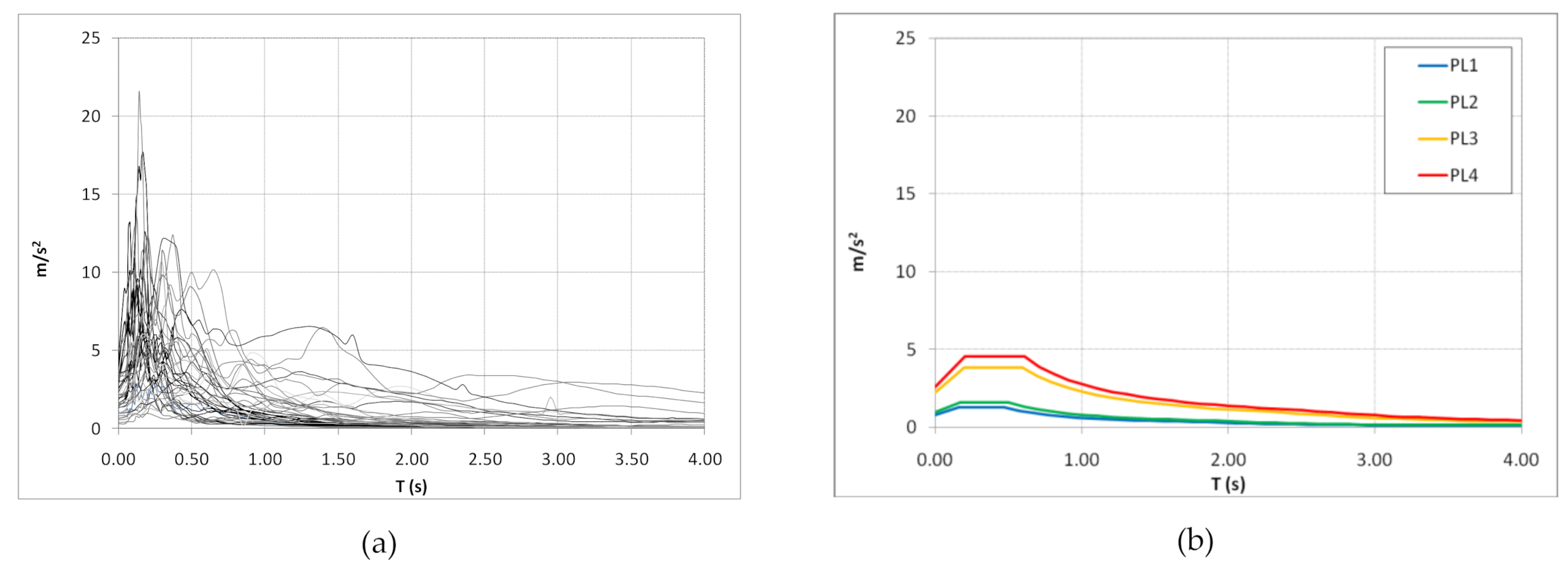


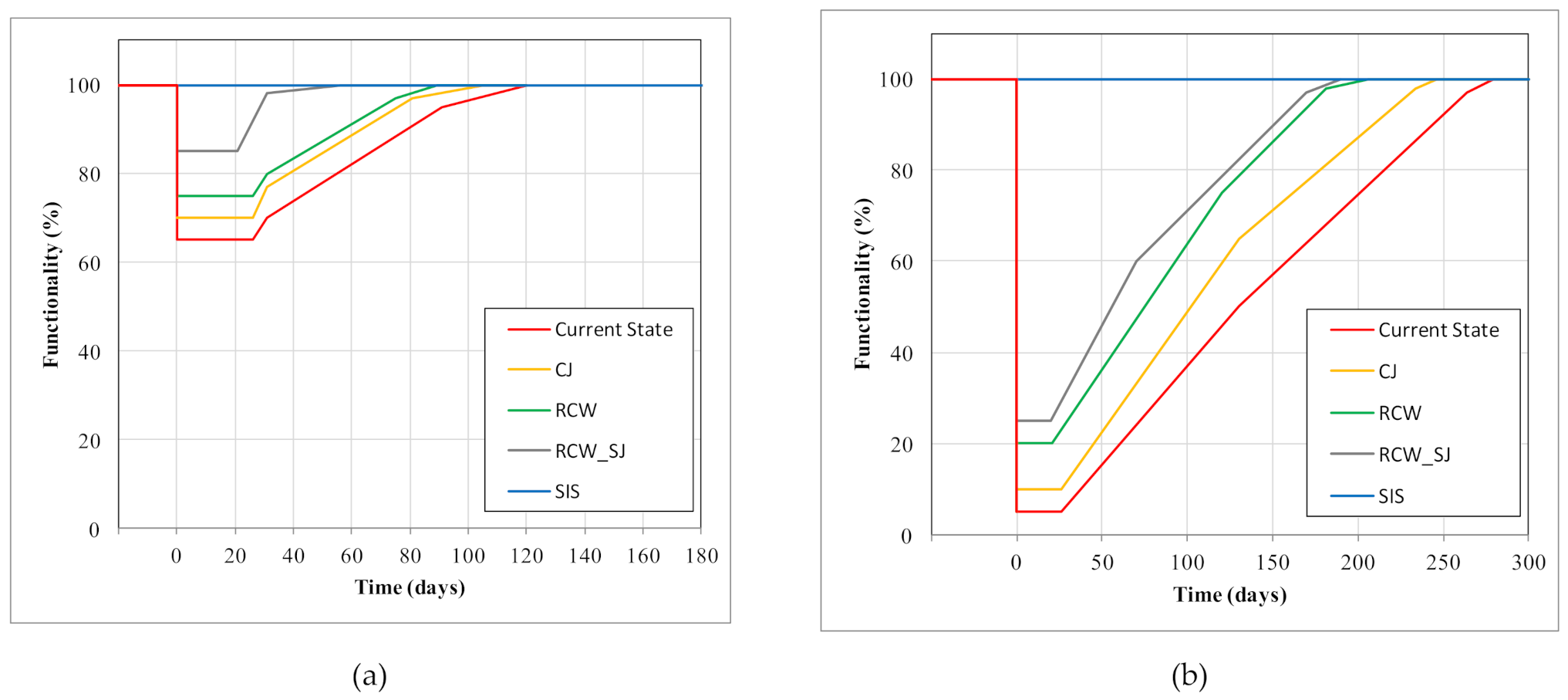
| ID | Level | Element Type | Unit Weight Kg/m3 | fc MPa |
|---|---|---|---|---|
| 1 | 1 | Column | 2212 | 23.69 |
| 2 | 1 | Column | 2212 | 16.53 |
| 73 | 1 | Column | 2242 | 23.69 |
| 4 | 2 | Column | 2242 | 18.53 |
| 5 | 2 | Column | 2126 | 18.55 |
| 6 | 2 | Column | 2210 | 20.86 |
| 7 | 3 | Column | 2293 | 36.90 |
| 8 | 3 | Column | 2210 | 22.83 |
| 9 | 2 | Beam | 2142 | 18.32 |
| 10 | 2 | Beam | 2228 | 31.41 |
| 11 | 3 | Beam | 2243 | 28.00 |
| Current State CS | Concrete Jackets CJ | RC Walls RCW | RC Walls and Steel Jackets RCW_SJ | Seismic Isolation System SIS | |
|---|---|---|---|---|---|
| PL1 | 0.739 | 0.810 | 0.865 | 0.965 | 1 |
| PL4 | 0.501 | 0.605 | 0.677 | 0.733 | 1 |
Publisher’s Note: MDPI stays neutral with regard to jurisdictional claims in published maps and institutional affiliations. |
© 2021 by the authors. Licensee MDPI, Basel, Switzerland. This article is an open access article distributed under the terms and conditions of the Creative Commons Attribution (CC BY) license (http://creativecommons.org/licenses/by/4.0/).
Share and Cite
Vona, M.; Flora, A.; Carlucci, E.; Foscolo, E. Seismic Retrofitting Resilience-Based for Strategic RC Buildings. Buildings 2021, 11, 111. https://doi.org/10.3390/buildings11030111
Vona M, Flora A, Carlucci E, Foscolo E. Seismic Retrofitting Resilience-Based for Strategic RC Buildings. Buildings. 2021; 11(3):111. https://doi.org/10.3390/buildings11030111
Chicago/Turabian StyleVona, Marco, Amedeo Flora, Emiliano Carlucci, and Enrico Foscolo. 2021. "Seismic Retrofitting Resilience-Based for Strategic RC Buildings" Buildings 11, no. 3: 111. https://doi.org/10.3390/buildings11030111
APA StyleVona, M., Flora, A., Carlucci, E., & Foscolo, E. (2021). Seismic Retrofitting Resilience-Based for Strategic RC Buildings. Buildings, 11(3), 111. https://doi.org/10.3390/buildings11030111







